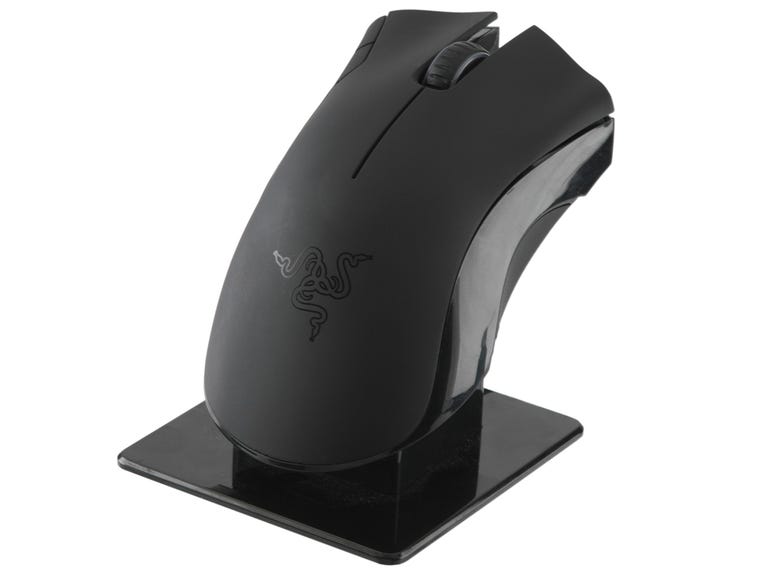 Why You Can Trust CNET
Why You Can Trust CNET Razer Mamba Wireless Gaming Laser Mouse 5600 DPI review: Razer Mamba Wireless Gaming Laser Mouse 5600 DPI
Razer Mamba Wireless Gaming Laser Mouse 5600 DPI
If you're a PC gamer who has balked at a wireless mouse because of reliability concerns, Razer's Mamba has the solution. Thanks to a high polling rate, the Mamba is the first mouse we've tested with lossless wireless connectivity. It also joins Microsoft's SideWinder X8 in offering a relatively seamless switch between wireless to wired usage modes. As you might expect, Razer isn't willing to part with such a uniquely high-performing mouse for nothing, and at $130, the Mamba is one of the most expensive mice we know of, short only of Logitech's outlandish $150 MX Air. If wireless PC gaming is that important to you, you will find little fault with the Mamba. The price tag will likely alienate everyone else.
The Good
The Bad
The Bottom Line
This mouse has curves in all the right places. The nearly symmetrical design feels comfortable in either hand, but the side buttons and general slopes of the Mamba are clearly biased for right-handed users. Rubber grips on both sides ensure that gamers with big or small hands will maintain a sturdy grip on the Mamba. The scroll wheel is smooth and comfortable with the ridged rubber surface and, like the matte finished section of the body, provides optimal grip without sacrificing comfort. The two standard buttons click with a crisp tactile feel.
Razer's driver software lets you configure custom button functions, profiles tied to applications, and also set macros. You can assign any of the Mamba's buttons to a specific profile, and then further embed that profile inside another one. That lets you assign profiles by game, and then even to certain roles in a game, for example to switch from on-foot controls to vehicle-based controls in Far Cry 2. We're also glad to have macro recording capability in the software, but we prefer Microsoft's easier on-the-fly macro recording with the SideWinder X8 via a dedicated button.
As stated, the Mamba has gone beyond the boundaries of necessity and boosted the laser sensitivity to 5,600dpi. We tend to feel anything beyond 2,000dpi or so is overkill, but perhaps you competitive gamers really do need such high sensor resolution. More universally useful is the 1,000MHz polling rate, which ensures no connection lag in either wired or wireless modes. That will surely appeal to anyone who plays hard but also wants to go cable free. It's also twice the polling rate of the SideWinder X8, which had a noticeable performance drop-off in wireless mode at high sensor resolutions.
You can toggle among five levels of laser sensitivity via the Mamba's DPI switching buttons tucked into the top-left corner. A series of lights on the side of the mouse changes from red to green to indicate the selected sensitivity. It isn't terribly insightful (and a battery indicator would be more useful here), but you can still understand the progression of lights in relation to the cursor speed. As with every other button on the Mamba, Razer's software lets you customize the DPI button settings, and save them into a profile.
Thanks to its onboard memory, the Mamba also allows you to carry both profiles and macros between computers or operating system installations without having to reassign them by hand. It only requires you to install the Razer drivers on the machine, which are freely downloadable. Logitech's similar G9 and G9x gaming mice also have onboard RAM, but the SideWinder X8 does not.
Razer has implemented a decent solution for switching between wired and wireless modes. The USB cable plugs into the charging base and mouse via a clunky boot-shaped connector. Similar to other mice of this type, most notably the Sidewinder X8, the Mamba will also recharge its included battery while the mouse is in wired mode. In the Mamba's case, you have to turn off the mouse first, via a switch on its underside.

Connecting and removing the cable from the Mamba's charging base is easy, but the same process with the mouse feels too unwieldy. Razer obviously designed the USB input to match the sculpt of the mouse and it's aesthetically pleasing enough. But actually plugging the cable into the Mamba requires just enough finesse to become annoying. The SideWinder X8's magnetic cable connection is much more seamless.
Finally, Razer rates the Mamba for 14 hours of "continuous" gaming battery life and 72 hours of stop-and-go gaming. Aside from plugging the Mamba into the USB cable, you can also simply mount it on the charging base, which displays the mouse like a trophy. You have to supply your own friends and family members interested enough to be impressed by a $130 gaming mouse.
